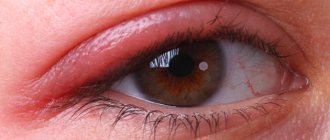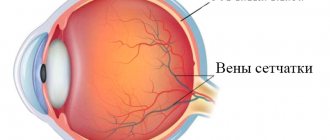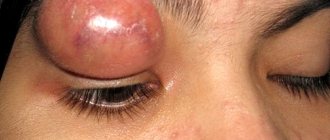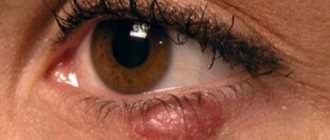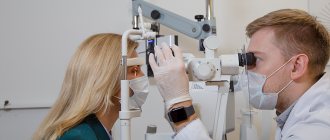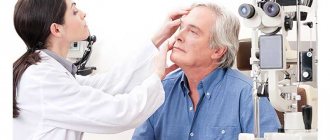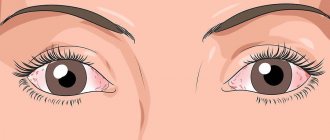Blockage of the meibomian glands leads to the development of blepharitis, an unpleasant and difficult to treat disease. The fatty secretion produced by the glands is needed to moisturize the eyes and reduce friction of the eyelids, and as a result of the disruption of its outflow, painful blisters form. What are the symptoms and treatment methods for such a disease?
In this article
- Meibomian blepharitis: symptoms, treatment
- Causes of meibomian blepharitis
- Diagnosis of the disease
- Meibomian blepharitis: treatment
- Complications after meibomian blepharitis
- The benefits of physiotherapeutic procedures for meibomian blepharitis
- How Meibomian Blepharitis Changes Your Lifestyle
- Prevention of meibomian blepharitis
Meibomian blepharitis: symptoms, treatment
Meibomian blepharitis, which affects the eyelids, is usually chronic and significantly impairs people's quality of life, as it requires ongoing treatment. During treatment of the disease, it is necessary to apply warm compresses and massage the eyelids to cleanse them of dead cells. What are the signs of meibomian blepharitis?
Symptoms of blepharitis:
- translucent, painful blisters along the edge of the eyelids;
- burning, itching and slight swelling in the affected areas;
- foamy discharge;
- the appearance of dry crusts on the eyelashes after sleep;
- eye fatigue even with minimal visual load;
- photophobia, blurred vision;
- abnormal growth and deformation of eyelashes (bend, break, fall out).
Since fatty secretion is part of the tear fluid, due to blockage of the glands it changes its qualities, and the mucous membrane of the eyes does not receive the necessary moisture. This is why meibomian blepharitis often presents with symptoms characteristic of dry eye syndrome.
Symptoms
Intact meibomian glands protect the tear film from evaporation. The blockage results in irritation of the ocular surface with increased blood circulation and redness of the conjunctiva. Fatty debris accumulates and forms a whitish-yellow mucus that resembles pus.
Clogging of the glands and disruption of the production of an oily film leads to inflammation of the eyelid. Blepharitis is accompanied by the following symptoms:
- rapid eye fatigue;
- increased sensitivity to light (appears only in severe cases of pathology);
- swelling of the eyelids in the affected area;
- eyelashes break and fall out greatly from the affected eyelid;
- eyes become sensitive to dust and wind;
- due to the accumulation of whitish-yellow mucus, a feeling of heaviness appears;
- crusts form on the eyelashes;
- increased lacrimation;
- foamy discharge appears;
- Possible deformation of the edges of the eyelids.
The eyelid and eyelash line are itchy, and there is a constant desire to scratch. Scratching leads to damage to the skin and allows other infectious agents to enter the wound. The course of the disease worsens.
Possible complications
With timely treatment, the disease does not cause complications. Recovery is going well without any unpleasant consequences.
If the pathology is not treated and left untreated, the following complications develop:
- scars on the eyelids;
- destruction of eyelash bulbs;
- trichiasis;
- abscess development;
- skin maceration;
- scleritis;
- keratitis;
- secondary glaucoma.
Visual acuity decreases. In case of any complication, it is impossible to use lenses to correct visual perception; they irritate the mucous membrane of the eye.
Causes of meibomian blepharitis
Inflammation of the meibomian glands is a common disease to which girls are more predisposed. This is due to the fact that they regularly use cosmetics, which is one of the main causes of blockage of the sebaceous glands located in the thickness of the cartilage of the eyelids.
Even makeup left unwashed overnight can cause blisters with hardened fatty secretions to appear. Cosmetics (mascara, eyeliner, eye shadow) are not the only reason why meibomian blepharitis develops.
Why does meibomian blepharitis occur:
- infectious diseases of the nasopharynx (infection provokes blockage of the sebaceous glands);
- use of low-quality decorative cosmetics, eye cream, etc.;
- The glands can also become inflamed due to metabolic disorders, a decrease in the body’s protective functions due to chronic diseases.;
- hormonal imbalances, diabetes mellitus, tuberculosis, gastritis (the composition of the secretion of the sebaceous glands changes).
In childhood, the disease occurs due to non-compliance with the rules of hand hygiene and improper care of the surface of the eyelids. In adults, this disease more often appears after 40 years of age; it is usually associated with infections in the body and metabolic disorders.
Types of blepharitis
Based on the causes of the onset and development of the disease, blepharitis is divided into several types:
According to clinical signs
- Scaly (simple) blepharitis
Manifests itself as redness and thickening of the edge of the eyelid, the formation of small dry scales at the base of the eyelashes and the release of a specific secretion. As the pathology progresses, eyelashes may turn gray, grow abnormally, or fall out. - Ulcerative blepharitis
is characterized by purulent inflammation of the eyelash follicles due to the penetration of Staphylococcus aureus into the cavity of the hair follicle. After this, ulcers appear along the inflamed edge of the eyelid and pus is released, which dries and forms crusts. After their removal, scars and wrinkles remain on the eyelids, which leads to deformation of the eyelids, abnormal eyelash growth, damage to the eyeball and decreased vision. - Demodectic blepharitis
Appears due to the penetration of demodex mites into the tissues of the eyelids, which feed on the secretions of the sebaceous glands. Patients are concerned about severe itching and pain in the eyes, inflammation of the eyelids, the appearance of sticky discharge from the eyes and white scales between the eyelashes. - Allergic blepharitis
Occurs against the background of allergies and worsens most often in the spring during the flowering period of grasses and trees. The pathology occurs suddenly and is manifested by profuse lacrimation, itching, inflammation and redness of the eyelids and conjunctiva, as well as increased photosensitivity. - Acne blepharitis (rosacea)
is characterized by the appearance of gray-pink purulent nodules on the skin of the eyelids, while the eyelids swell and itch. The disease may also be accompanied by the formation of rosacea on the face and around the eyes. - Meibomian blepharitis
Develops due to dysfunction of the meibomian glands, in which the secreted secretion is poorly excreted due to blockage of the gland ducts. The eyelids look swollen and shiny, as if oiled. Also, small yellowish dots appear on the surface of the edge of the eyelids, and bubbles appear at the base of the eyelashes.
By localization of inflammation
- Anterior marginal blepharitis - affects only the ciliary edge of the eyelid.
- Posterior marginal blepharitis - in addition to the eyelid, its meibomian glands become inflamed; inflammation can spread to the conjunctiva and cornea.
- Angular blepharitis - inflammation is localized in the corners of the eyes.
Diagnosis of the disease
A qualified specialist will be able to determine the type of disease based on the existing symptoms. Depending on whether meibomian blepharitis or another type of disease develops, treatment will be prescribed. If the symptoms are unclear, there are complications in the form of conjunctivitis with copious purulent discharge, a study of scrapings from the conjunctiva may be prescribed. This test will rule out or confirm a bacterial infection. It is possible that you will need to consult other specialists: an allergist, a dermatologist. This is necessary to exclude another nature of the origin of the disease.
Meibomian blepharitis: treatment
Painful blisters with meibomian inflammation cause considerable discomfort, but you should not try to squeeze them out, as this can lead to the appearance of scars, which will lead to improper eyelash growth. The bubbles contain a transparent, oily secretion, and to allow it to come out, it is necessary to make warm compresses by applying lotions to the eyelids. Therapy for meibomian blepharitis includes a set of useful measures.
Treatment of blepharitis:
- elimination of foci of infection, treatment of diseases that caused blepharitis - antimicrobial drugs are prescribed by a doctor;
- thoroughly cleansing the eyelids of crusts and dried secretions - for this you can use a warm solution of an antiseptic, for example, furatsilin, as well as herbal decoctions;
- daily massages with medicinal ointments - massage is conveniently done with a special stick, which helps remove stagnant secretions;
- using moisturizing eye drops;
- compresses, hardware therapy.
The effectiveness of treatment depends on whether the doctor was able to find the cause of the disease. Without eliminating it, it will be difficult to cope with the disease, since the secretion will periodically harden, forming gray-yellow bubbles.
Therapy methods
Treatment for meibomian blepharitis begins with a visit to an ophthalmologist. To make a diagnosis, the doctor performs a simple diagnostic procedure:
- pulls out several eyelashes from the patient;
- scrapes (cleanses off with a special spatula) the secretion;
- examines the obtained biological material under a microscope on clean glass.
The doctor looks for Demodex - those very microscopic mites - and determines their number.
He can also examine the eyelid by turning it outward. If you compare a photo of the conjunctiva of a healthy person and a patient with blepharitis, you can easily notice the presence of enlarged sebaceous glands on the eyelid. This symptom helps to differentiate the disease and give the patient an accurate diagnosis. After conducting an examination and studying the secretion, the ophthalmologist immediately prescribes treatment, which includes: carrying out hygiene procedures, using ointments and drops. If the secretion has changed color and there are signs of infection, the doctor may prescribe topical antibiotics. Meibomian blepharitis can also be treated using gymnastic procedures. Using saline solution and a cotton pad, the patient should clean the eyelid of accumulated secretions. “Crusts” are removed and discharge is cleared from the eyelashes. Procedures are carried out as often as possible, at least 2-3 times a day.
Afterwards, moisturizing drops are instilled into the eyeballs. 1-2 drops into each conjunctival sac. Ointments can be used in treatment; they are placed behind the eyelid. They help reduce irritation, hyperthermia and other unpleasant symptoms. To correct photophobia, it is recommended to use sunglasses. If the reaction to light is too painful.
Complications after meibomian blepharitis
Blockage of the sebaceous glands leads to disruption of the composition of tears, creating favorable conditions for the spread of bacteria. This occurs because the mucous membrane of the eyes with meibomian blepharitis is not sufficiently moisturized, which increases the feeling of dryness and burning. Such dryness can cause conjunctivitis if viruses and microbes begin to spread on the mucous membrane of the eyes. The appearance of a bacterial infection is indicated by the presence of purulent discharge. If such symptoms are present, treatment should include antimicrobials.
Bacterial conjunctivitis is one of the serious complications of blepharitis. Its treatment will require the use of broad-spectrum antibiotics in the form of ointments and eye drops. What other complications could there be? With prolonged insufficient treatment of blepharitis, the appearance of chalazion, barley, involvement of the cornea in the inflammatory process, etc. is possible.
Causes of blepharitis
The etiology of blepharitis is varied, which indicates that this disease is often a symptom of various pathological conditions. Among the many causes of the disease, the leading place is occupied by staphylococcal infection and seborrhea.
Among the infectious factors in the development of the disease there are:
- Bacterial infection (Staphylococcus aureus and S. epidermidis, Streptococcus pneumoniae, Haemophilus influenzae, Moraxella lacunata).
- Viral infection (herpes simplex viruses types I, II and III, molluscum contagiosum).
- Pathogenic fungi (Pityrosporum ovale and P. orbiculare).
- Arthropods (Demodex folliculorum humanis mites and Phthirus pubis lice).
Blepharitis of a non-infectious nature occurs with seborrhea, eczema and rosacea.
Allergic blepharitis develops in individuals with hypersensitivity to plant pollen, medications, hygiene products, etc. Allergization of the body of endogenous nature develops with helminthiasis, diseases of the gastrointestinal tract (gastritis, colitis, cholecystitis), diabetes mellitus, tuberculosis, etc. Promote the development blepharitis triggers such as smoke, dust, wind, heat, excessive insolation, etc.
Predisposing factors for the development of blepharitis:
- Diseases of the lacrimal ducts, chronic conjunctivitis, eczema, contact dermatitis.
- The presence of foci of endogenous infection (tonsils, paranasal sinuses, oral cavity, skin, etc.).
- Decreased immune status of the body (hypovitaminosis, anemia, chronic intoxication, chemotherapy, HIV infection, immunosuppressive therapy, etc.).
- Uncorrected ametropia and dry eye syndrome often contribute to the development of the disease.
Figure 2. Photo shows acute blepharitis.
The benefits of physiotherapeutic procedures for meibomian blepharitis
For blepharitis, treatment using devices is highly effective. The duration of the course is determined by the doctor, taking into account the characteristics of the disease. What procedures are effective in treating blepharitis:
- UHF - anti-inflammatory effect, relieving swelling, softening hardened secretions;
- magnetotherapy - increased blood flow, improved metabolic processes;
- electrophoresis - this treatment is performed using a drug that is injected with direct current into the upper layer of the epidermis;
- ultraviolet radiation has a tonic, bactericidal, anti-inflammatory effect.
For the effectiveness of hardware therapy to be high, regularity is necessary. Try not to miss treatment sessions and complete the entire course prescribed by the specialist.
How Meibomian Blepharitis Changes Your Lifestyle
With blepharitis caused by blockage of the sebaceous glands, the eyelids look swollen, oily, and dry eyes are noted due to the changed composition of tears (lack of oily secretion). For this reason, wearing contact lenses will be problematic. In addition to pain due to blepharitis, painful sensations may also appear due to increased sensitivity of the eyes. You should not risk your health and continue to wear lenses, even if you are used to them and do not want to go back to glasses.
The less stress on the visual organs during the treatment period, the sooner the recovery will occur (provided that the full range of therapeutic measures is performed). By daily performing all the necessary manipulations to clean, soften the eyelids, as well as doing massages to soften and remove secretions, you can get rid of the symptoms of blepharitis.
Prevention of meibomian blepharitis
To prevent relapses of the disease, comprehensive prevention is necessary, including vitamin supplementation, a balanced diet, eyelid hygiene, as well as actions aimed at improving metabolism and strengthening the immune system. In the first time after recovery, it is better to stop using decorative cosmetics, allowing the body to recover. Subsequently, use only high-quality hypoallergenic cosmetics, observing their shelf life.
The daily diet of a person prone to blepharitis must include vegetables and fruits, mushrooms, nuts, legumes, foods rich in lutein, vitamins A, C, E. The use of flaxseed oil, which has an anti-edematous and anti-inflammatory effect, will be useful. It can be added to cold dishes and sauces, to season salads and porridges. Try to avoid overheating and hypothermia, physical and nervous stress - all this can trigger the appearance of meibomian blepharitis.
Treatment of pathology
Therapy for meibomian blepharitis is primarily aimed at restoring the functioning of the glands to normal. And the main procedure to achieve the desired result is eyelid massage. It is performed using a glass rod and drugs from the antiseptic groups, as well as disinfectants. Since the procedure is not entirely pleasant, it is recommended to perform it under local anesthesia.
Advice! Before starting the massage, it is necessary to remove the dried secretion using an alcohol solution.
Treatment of pathology requires an integrated approach. The following medications can be used to treat inflamed eyelids:
- tetracycline ointment (1%);
- sulfacyl ointment (10-20%);
- syntomycin liniment (1%), etc.
After the infectious agent that triggered the development of blepharitis is isolated, the doctor prescribes a course of antibiotic treatment.
Hygiene procedures
Another important stage in the treatment of inflammation is hygienic cleaning of the affected eyelids. To remove dried secretions you can use:
- alcohol solutions;
- alcohol-ether mixtures.
All scales and sebaceous plugs must be removed, as they prevent the sebaceous glands from working normally. The processing looks like this:
- The upper eyelid is cleaned first. This is done with the eye closed.
- The lower eyelid is cleaned with the eye open.
Advice! To avoid blinking while treating the eyelids, slightly stretch the skin at the outer corner of the eye.
Additional treatment
A speedy recovery directly depends on the functioning of the immune system. This is why it is so important to take vitamins and immunostimulating agents. In particular, quite often the drug “Immunal” is prescribed for use in this case.
The main active ingredient is Echinacea purpurea juice in combination with other components of plant origin. The following procedures give good results:
- autohemotherapy;
- irradiation with Bucca rays;
- physiotherapy sessions.
From folk remedies, you can use traditional washes and lotions from decoctions of medicinal herbs, as well as black and green teas.
